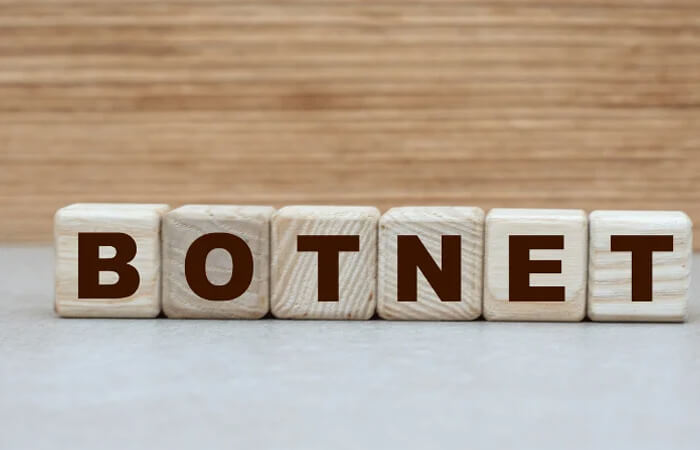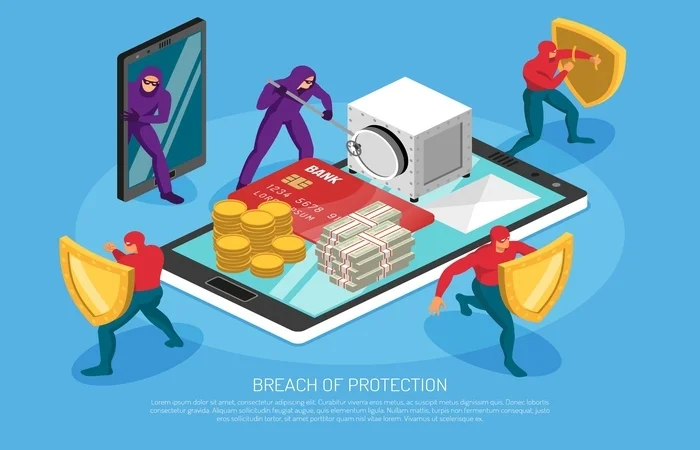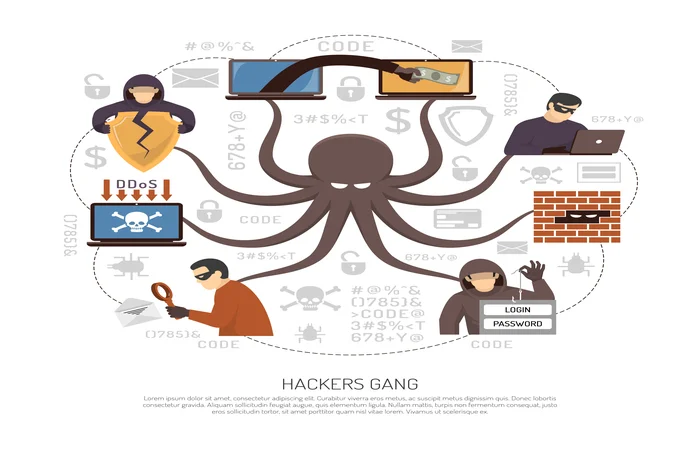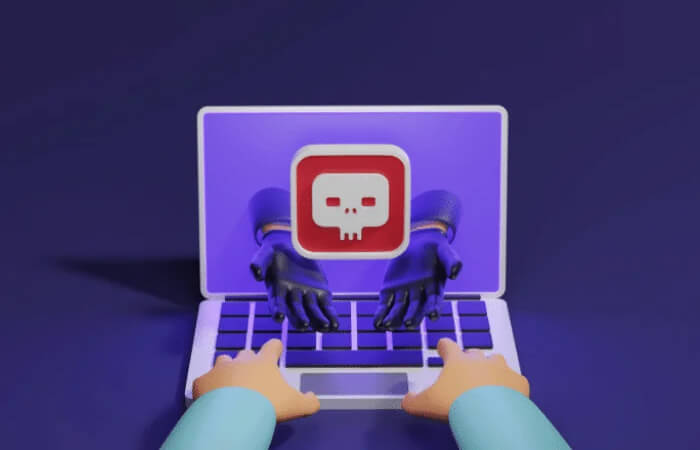
Günümüz dijital dünyasında, botnet saldırıları giderek artan bir tehdit haline gelmiştir. Botnetler, bilgisayar korsanlarının hedef sistemlere sızarak milyonlarca cihazı ele geçirmesini ve kontrol altına almasını sağlayan karmaşık ağlardır. Bu bot ağları, genellikle kullanıcıların farkında olmadan çalışır ve saldırganlara güçlü bir silah sunar. Botnet saldırıları, siber suçluların çeşitli hedeflere karşı hırsızlık, kimlik avı, fidye saldırıları ve hatta siber savaş faaliyetleri gibi zararlı niyetlerini gerçekleştirmelerine olanak tanır. Bu saldırılar, hem bireysel kullanıcıları hem de kurumsal ağları etkileyebilir, önemli veri kayıplarına, finansal zararlara ve itibar kaybına neden olabilir. Bu makalede, botnet saldırılarının nasıl çalıştığını, yaygın kullanım alanlarını ve potansiyel etkilerini detaylı bir şekilde inceleyerek, bu tehditle mücadele etmek için alınabilecek önlemleri ele alacağız.
Botnet ağları, genellikle bir grup kötü niyetli kişi veya organizasyon tarafından kontrol edilen enfekte cihazlardan oluşan karmaşık bir yapıya sahiptir. Bu ağlar, genellikle virüs, truva atı veya kötü amaçlı yazılımlar aracılığıyla hedeflenen cihazlara bulaşarak oluşturulur. Botnetlerin hedefi, bilgisayarlar, akıllı telefonlar, tabletler, IoT cihazları ve hatta sunucular gibi çeşitli cihazlardır.
Bir botnet ağı oluşturmak için saldırganlar, ilk adımda, hedef cihazlara bulaşması için zararlı bir yazılım dağıtır. Bu zararlı yazılım genellikle, kullanıcıların farkında olmadan indirdiği veya güvenlik açıklarını kullandığı hileli dosyalardan gelir. Zararlı yazılım bir kez hedef cihaza bulaştığında, saldırganlara geri dönüt sağlayan ve komutlarını alan bir “bot” olarak faaliyet göstermeye başlar.
Botnet ağının ana kontrol noktası, saldırganların “command and control” (C&C) sunucusu olarak adlandırdığı merkezi bir sunucudur. Bu sunucu, saldırganların tüm botlara yönlendirdiği komutları ve talimatları ileteceği bir merkezi kontrol noktasıdır. Saldırganlar, bu komutlar aracılığıyla botnet ağına bağlı tüm enfekte cihazları eşzamanlı olarak kontrol edebilir ve belirli eylemler gerçekleştirmelerini sağlayabilir.
Botnet ağları, enfekte cihazları kullanarak farklı saldırı taktikleri uygulayabilir. Örneğin, DDoS (Distributed Denial of Service) saldırılarıyla hedef sistemlere yoğun miktarda trafik göndererek kaynaklarını tüketebilir ve çökmesine neden olabilir. Ayrıca, botnetler, kimlik avı saldırıları, veri hırsızlığı, fidye saldırıları ve spam gönderimi gibi zararlı faaliyetleri gerçekleştirebilir.
Botnet Saldırı Türleri
1- DDoS Saldırıları (Distributed Denial of Service)
Botnetler genellikle DDoS saldırıları için kullanılır. Bu saldırı türünde, botnetin kontrolündeki enfekte cihazlar, hedef sistem veya ağa yoğun miktarda trafiğin gönderilmesini sağlar. Bu trafiğin yoğunluğu, hedefin kaynaklarını tüketir ve hizmetlerin normal şekilde çalışmasını engeller, böylece hedef sistemleri kullanılamaz hale getirir.
2- Kimlik Avı Saldırıları
Botnetler, kullanıcıları hedefleyen kimlik avı saldırılarında da kullanılır. Botnet sahipleri, kullanıcıları hileli e-postalar veya sahte web siteleri aracılığıyla kandırarak kişisel bilgilerini veya giriş kimliklerini çalmaya çalışırlar. Bu bilgiler daha sonra kötü niyetli amaçlar için kullanılabilir.
3- Veri Hırsızlığı
Botnetler, bilgisayarların ve ağların içine sızarak veri hırsızlığı yapabilir. Enfekte cihazlar aracılığıyla saldırganlar, kullanıcıların kişisel bilgilerini, finansal verilerini veya hassas şirket bilgilerini ele geçirebilir. Bu bilgiler daha sonra kötü amaçlı faaliyetlerde kullanılabilir veya kara borsalarda satılabilir.
4- Fidye Saldırıları
Botnetler, fidye yazılımlarının dağıtımında kullanılır. Enfekte cihazlar aracılığıyla saldırganlar, hedef sistemlere zararlı yazılımlar bulaştırır ve ardından dosyaları şifreleyerek erişimi engeller. Ardından fidye talep ederek, dosyaların çözülmesi için ödeme yapılmasını isteyebilirler.
5- Spam Gönderimi
Botnetler, büyük miktarda spam e-posta göndermek için kullanılabilir. Enfekte cihazlar, sahte e-postaları oluşturarak zararlı içerik veya istenmeyen reklamlar içeren e-postaları hedeflere gönderir. Bu, spam filtrelerini aşmayı ve istenmeyen içeriklerin yayılmasını kolaylaştırır.
Botnet saldırıları nasıl gerçekleştirilir?

Botnet saldırıları, genellikle aşağıdaki adımlarla gerçekleştirilir:
Bulaşma Aşaması
Botnet saldırılarında bulaşma aşaması, saldırganların hedef cihazlara zararlı yazılım bulaştırmayı hedeflediği kritik bir adımdır. Bu adım, siber saldırganların hedef cihazları ele geçirmek ve botnet ağına dahil etmek için kullanılan yöntemleri içerir. Enfeksiyon genellikle, saldırganların çeşitli yöntemleri ve taktikleri ustalıkla kullanmasıyla gerçekleştirilir.
- Saldırganlar, enfeksiyonu başlatmak için çeşitli araçları kullanır. Örneğin, e-posta ekleri veya kötü amaçlı bağlantılar aracılığıyla kullanıcıları kandırmaya çalışır. E-posta eklerinde veya bağlantılarda gizlenen zararlı yazılımlar, kullanıcıların güvenlik açıklarını sömürerek cihaza bulaşır. Bunun yanı sıra, exploit kitleri ve güvenlik açıklarını hedefleyen saldırılar da enfeksiyon sürecinde sıkça kullanılır. Saldırganlar, güvenlik açıklarını tespit ederek cihazlara sızma girişiminde bulunur ve zararlı yazılımı hedef sistemlere bulaştırır.
- Enfekte olan hedef cihazlar, kontrol sunucusuyla iletişim kurarak botnet ağına katılmaya çalışır. Zararlı yazılım, saldırganların kontrolünde olan sunuculara bağlanarak komutlar alır ve saldırganın isteğine göre hareket eder. Bu şekilde, binlerce hatta milyonlarca cihazdan oluşan botnet ağı oluşturulur.
- Enfeksiyon aşaması, siber saldırganların gelişmiş teknikler ve stratejiler kullandığı karmaşık bir süreçtir. Saldırganlar, kullanıcıları kandırmak için sosyal mühendislik taktiklerini, güvenlik açıklarını tespit etmek için otomatik araçları ve karmaşık kodlama yöntemlerini kullanır. Bu nedenle, kullanıcıların güvenlik bilincini artırmak, güncel yazılımları kullanmak ve güvenlik açıklarını düzeltmek gibi önlemler almak büyük önem taşır.
Bot Ağının Oluşturulması
Enfekte cihazlar, kontrol sunucusu tarafından belirlenen komutları ve talimatları almak üzere botnet ağına bağlanır. Bu aşamada, enfekte cihazlar “botlar” haline gelir ve saldırganların kontrolü altında çalışır. Botlar, kontrol sunucusuyla düzenli olarak iletişim kurar ve saldırganların talimatlarını alır.
Komuta ve Kontrol
Botlar, kontrol sunucusundan aldıkları komutları ve talimatları uygulamak üzere programlanır. Bu talimatlar, DDoS saldırıları, kimlik avı saldırıları, veri hırsızlığı veya diğer zararlı faaliyetler gibi çeşitli saldırı türlerini içerebilir. Kontrol sunucusu aracılığıyla saldırganlar, tüm botlar üzerinde eşzamanlı olarak komut gönderebilir ve botnet ağını koordine eder.
Saldırı Aşaması
Botnet sahipleri, botnet ağındaki botları kullanarak belirlenen hedeflere saldırı yürütür. Örneğin, DDoS saldırılarında botlar, hedef sistem veya ağa yoğun trafik gönderir, kaynaklarını tüketir ve hizmetlerin normal şekilde çalışmasını engeller. Kimlik avı saldırılarında botlar, sahte web siteleri veya hileli e-postalar aracılığıyla kullanıcıları kandırarak kişisel bilgilerini çalmaya çalışır.
Gizlilik ve Süreklilik
Botnet saldırıları genellikle saldırganların izini sürmenin zor olduğu şekilde tasarlanır. Saldırganlar, enfekte cihazlar arasında iletişimi şifreleyebilir veya farklı IP adreslerini kullanabilir. Ayrıca, botnetlerin devamlılığı için sürekli olarak yeni enfekte cihazlar keşfedilmeye çalışılır. Saldırganlar, güvenlik önlemlerini aşmak ve bot ağlarını gizlemek için farklı yöntemler ve araçlar kullanır.
Botnet Yönetimi
Botnet sahipleri, botnet ağını yönetmek için yönetim araçları ve kontrol panelleri kullanır. Bu araçlar, enfekte cihazların durumunu izlemek, yeni enfekte cihazları eklemek, komutlar göndermek ve genel olarak botnetin faaliyetlerini yönetmek için kullanılır. Saldırganlar, bot ağındaki botları güncellemek, yeni saldırı taktikleri geliştirmek ve botnetin verimliliğini artırmak için sürekli olarak çalışır.

Botnet saldırılarının hedefinde kimler vardır?
Botnet saldırıları, çeşitli sektörlerdeki kişilere ve kuruluşlara yönelik gerçekleştirilebilir. Aşağıda, botnet saldırılarının hedefinde yer alabilecek bazı potansiyel kişiler ve kuruluşlar bulunmaktadır:
- Bireysel Kullanıcılar: Botnet saldırıları, bireysel kullanıcıları hedefleyebilir. Saldırganlar, enfekte edilmiş cihazlar aracılığıyla kişisel bilgileri çalmak, fidye talepleri göndermek veya kimlik avı saldırıları gerçekleştirmek gibi kötü niyetli faaliyetlerde bulunabilir.
- Şirketler ve Kuruluşlar: Botnet saldırıları, şirketlerin ve kuruluşların siber güvenliğini hedef alabilir. Saldırganlar, şirket ağlarına sızarak veri hırsızlığı yapabilir, şirket bilgilerini ele geçirebilir veya ağ hizmetlerini engelleyebilir. Ayrıca, fidye saldırılarıyla şirketlerden para talep edebilir veya itibarlarını zedeleyebilir.
- Kamu Kurumları ve Hükümetler: Botnet saldırıları, kamu kurumları ve hükümetler üzerinde önemli bir tehdit oluşturur. Saldırganlar, hükümet ağlarına sızarak hassas bilgilere erişebilir, hükümet hizmetlerini engelleyebilir veya bilgi sızıntılarına neden olabilir. Bu tür saldırılar, bir ülkenin kritik altyapısına yönelik bir tehdit oluşturabilir.
- Finansal Kuruluşlar: Botnet saldırıları, bankalar, ödeme işlemcileri ve diğer finansal kuruluşlar gibi finans sektöründeki kuruluşları hedef alabilir. Saldırganlar, bu kuruluşlara yönelik kimlik avı saldırıları gerçekleştirerek müşteri bilgilerini ele geçirebilir veya maddi kaynakları hedef alabilir.
- E-Ticaret Siteleri: Botnet saldırıları, e-ticaret sitelerini hedef alarak maddi kazanç sağlamayı amaçlayabilir. Saldırganlar, bu sitelere yönelik DDoS saldırıları gerçekleştirerek hizmetlerin kesintiye uğramasına neden olabilir veya kullanıcıların bilgilerini çalabilir.
Dünyada Bilinen Önemli Botnet Saldırıları
EarthLink Spammer – 2000
Botnetlerin ilk olarak geniş çapta tanındığı vaka, 2000 yılında Khan K. Smith tarafından oluşturulan bir spam göndericinin ortaya çıkmasıdır. Bu botnet, bir yıldan biraz daha uzun bir süre içinde 1,25 milyon e-posta göndererek (meşru web sitelerinden gelen iletişimleri taklit eden kimlik avı dolandırıcılığı) büyük bir etki yarattı. Smith, kredi kartı numaraları veya bilgisayarlara bulaşan virüsler gibi hassas bilgileri toplamayı ve uzaktan bilgi edinmeyi umuyordu. Ancak, EarthLink tarafından 25 milyon dolarlık bir dava ile karşı karşıya kalan Smith, ağlarını spam planı için kullandığı gerekçesiyle suçlandı. Bu dava ona en az 3 milyon dolar kazandırdı.
https://www.bizjournals.com/atlanta/stories/2002/07/22/story4.html?page=all
Cutwail – 2007
2009 yılında, spam botnet Cutwail, dakikada 51 milyon e-posta göndererek dünya genelindeki spam hacminin %46,5’ine katkıda bulunuyordu. Cutwail, yaklaşık 1,5 milyon virüslü makineden oluştuğu için, onu kapatma çabaları son derece etkisiz kaldı. 2014 yılında FBI, Europol ve diğer kolluk kuvvetleri tarafından gerçekleştirilen bir müdahaleye rağmen, bugün bile botnet hala aktif durumda ve kiralanabilir bir hizmet olarak sunulmaktadır.
https://www.wired.co.uk/article/infoporn-rise-and-fall-of-uks-biggest-spammer
Grum – 2008
Grum, farmasötik spam konusunda uzmanlaşmış bir spam botnetti ve oldukça büyük bir ölçekte faaliyet gösteriyordu. 2009 yılında, Grum günde 39,9 milyar mesaj göndererek dünya genelindeki istenmeyen postaların %18’ini oluşturuyordu. Ancak, kolluk kuvvetleri Grum’un komuta ve kontrol merkezlerini keşfetmek için yoğun bir çalışma yürüttü. Bu operasyon, 2012 yılında başarıyla gerçekleştirildi ve merkezlerin Hollanda’dan Panama’ya kadar olan bölgelerde olduğu tespit edildi. Bu müdahale sayesinde Grum’un faaliyetleri durduruldu ve spam botnetin etkisi büyük ölçüde azaltıldı.
https://www.zdnet.com/article/officials-attack-grum-worlds-third-largest-botnet-18-of-spam/
Kraken – 2008
Kraken botnet’in tam boyutu hakkında kesin bir bilgi olmasa da, geniş kapsamı göz ardı edilemez. Tahminlere göre, Kraken’in Fortune 500 şirketlerinin %10’unu etkilediği ve yaklaşık 495.000 botun her birinin günlük olarak 600.000’e kadar e-posta gönderebileceği düşünülüyor. Botnet, kötü amaçlı yazılımdan koruma yazılımı tarafından tespit edilmekten kaçınmak için kaçırma tekniklerini kullanmasıyla dikkat çekti. Kraken, güncellendiğinde bile otomatik olarak güncellenen ilk gözlemlenen botnetlerden biriydi. Kraken bugün aktif olmasa da, geçmişte güvenlik sistemleri tarafından tespit edilen kalıntıları vardır ve gelecekte yeniden ortaya çıkma potansiyeline sahiptir.
https://www.welivesecurity.com/2015/02/25/nine-bad-botnets-damage/
Methbot – 2016
Methbot, sahtekarlıkla yüz binlerce IP adresini iki küresel internet kayıt defterinden elde etti ve bunları ABD merkezli internet hizmet sağlayıcıları ile ilişkilendirdi. Bu botnetin operatörleri, birinci sınıf yayıncılar gibi görünen 6.000’den fazla alan adı ve 250.267 farklı URL oluşturdu. Reklamverenlerin bu alan adlarına teklif vermesini sağladı ve ardından botlarını her gün yaklaşık 300 milyon video reklamını “izlemesi” için gönderdi. Methbot, 2015 yılında White Ops tarafından keşfedildi ve tamamen engellendi. Ancak, Methbot’un yeniden ortaya çıkma işaretlerini her zaman gözlemlemekteyiz ve bu nedenle dikkatli olunması gerekmektedir.
Mirai – 2016
Mirai botnet, büyük çaplı bir dağıtılmış hizmet reddi (DDoS) saldırısıyla ABD’nin doğu kıyısındaki birçok internet hizmetine erişimi engelledi. Ancak Mirai’yi öne çıkaran şey, güvenli olmayan IoT (nesnelerin interneti) cihazlarına bulaşan ilk büyük botnet olmasıydı. En yüksek noktasında, solucan 600.000’den fazla cihaza yayıldı. Bunun en şaşırtıcı yanı ise botnet’in Minecraft oyununda avantaj sağlamak isteyen bir grup üniversite öğrencisi tarafından oluşturulmuş olmasıdır. Mirai, bu IoT cihazlarına saldırmak için basit şifrelerin veya zayıf güvenlik önlemlerinin kullanılmasından yararlanmıştır. Bu olay, güvenlik açısından zayıf olan IoT cihazlarının potansiyel risklerini ve botnet saldırılarının geniş kapsamını gösteren önemli bir dönüm noktası oldu.
https://www.wired.com/2016/10/internet-outage-ddos-dns-dyn/

Türkiye’de ve Dünyada Bilinen botnet saldırıları
MisoSMS
Güvenlik şirketi FireEye tarafından keşfedilen tehlikeli bir botnet olan MisoSMS, Güney Kore’deki kullanıcıların SMS’lerini tarayarak çalmaktadır. Çalınan SMS’ler daha sonra Çin’deki hacker‘ların e-posta adreslerine gönderilmektedir. Bu botnet, kendisini Google Vx olarak tanıtan bir uygulamanın kurulumuyla harekete geçmektedir.
Uygulama, kullanıcılardan yönetici yetkilerini istemekte ve pek çok kullanıcı, tehlikenin farkına varmadığı için izin vermektedir. Uygulama, kullanıcının onayını aldıktan sonra SMS’leri çalmaya başlamaktadır. Ardından, çalınan SMS’ler toplu olarak hacker’larla paylaşmak üzere 450’den fazla e-posta hesabıyla kontrol edilen bir sistem üzerinden gönderilmektedir. FireEye’a göre, hacker’lar düzenli olarak çalınan SMS’leri okumaktadır.
https://www.sozcu.com.tr/2013/teknoloji/smsleriniz-okunuyor-olabilir-426908/
Cumhurbaşkanı Erdoğan ve Libya Operasyonunu hedef alan bot
Twitter üzerinde faaliyet gösteren ve Birleşik Arap Emirlikleri ve Suudi Arabistan’ın siyasi çıkarlarına hizmet eden 9.000’den fazla bot hesaptan oluşan bir ağın tespit edildi ve kapatıldı. Bu bot ağı, Cumhurbaşkanı Recep Tayyip Erdoğan’ı hedef alarak Türkiye’nin Libya’ya müdahalesini eleştiren gönderiler yayınlıyordu. Ayrıca, COVID-19 salgınını politik amaçlarla kullanmaya yönelik paylaşımlarda bulunuyordu.
Ağ, ilk olarak 2019 Aralık ayında Stanford Internet Observatory tarafından Twitter’a bildirildi ve daha sonra Indiana merkezli bir araştırmacı tarafından keşfedildi. Digital Forensic Research Lab (DFRLab) ve BuzzFeed ile paylaşılan hesaplar, bot hesabı olduğunu doğrulayan analizlerle incelendi. Bu bot ağı, belirli amaçlar doğrultusunda hashtag kullanımıyla kampanyaları desteklemek ve kitlelere daha fazla ulaşım sağlamak gibi işlevlere hizmet ediyordu.
DFRLab, Koreli bir pop grubunun tanıtımından Hindistan’daki siyasi kampanyalara kadar farklı suni gündem oluşturucu bot ağlarını belgeledi ve Birleşik Arap Emirlikleri’nin Libya ve diğer bölgelerdeki çıkarlarını desteklemek amacıyla Twitter üzerinde yürütülen koordineli operasyonlar hakkında kapsamlı bir rapor hazırladı.
Bilgisayarınızın Botnet’in bir parçası olmasını nasıl önleyebilirsiniz?
- Güncel Kalın: İşletim sisteminizi, uygulamalarınızı ve güvenlik yazılımlarınızı düzenli olarak güncelleyin. Güncellemeler, bilgisayarınızın güvenliğini artırmak ve bilinen güvenlik açıklarını gidermek için önemlidir.
- Güçlü Şifreler Kullanın: Güçlü ve benzersiz şifreler kullanarak hesaplarınızı koruyun. Şifrelerin karmaşık olması, tahmin edilemez olması ve birden fazla faktörle (örneğin iki faktörlü kimlik doğrulama) güçlendirilmesi önemlidir.
- Güvenlik Yazılımı Kullanın: Güvenlik yazılımları,, kötü amaçlı yazılımları tespit etmek, engellemek ve ortadan kaldırmak için kritik bir öneme sahiptir. Kötü niyetli yazılımların tespit edilmesi ve izinsiz erişim girişimlerinin engellenmesi, ağ güvenliğinin sağlanması için temel bir gerekliliktir.
Güvenlik yazılımları arasında antivirüs programları, zararlı yazılımları algılamak ve temizlemek için kullanılır. Bu yazılımlar, bilgisayarınızı sürekli olarak tarar ve bilinen kötü amaçlı yazılımları tespit eder. Güvenlik duvarı ise ağınızı koruma altına alır ve istenmeyen erişimlere karşı bir bariyer oluşturur. İzin verilmeyen ağ trafiğini engelleyerek, ağınızın güvenliğini artırır.
Birçok network admini, güvenlik yazılımları olarak örneğin, Kaspersky, Symantec, McAfee gibi tanınmış ve güvenilir markaları tercih eder. Bu yazılımlar geniş bir kötü amaçlı yazılım veritabanına sahiptir ve sürekli olarak güncellenerek yeni tehditlere karşı koruma sağlar.
Ayrıca, güvenlik yazılımlarının düzenli olarak güncellenmesi de büyük önem taşır. Saldırganlar, sürekli olarak yeni ve sofistike kötü amaçlı yazılımlar geliştirirken, güncellemeler bu yeni tehditlerle mücadele etmek için önemlidir. Bu nedenle, güvenlik yazılımlarının otomatik güncelleme özelliğinin etkinleştirilmesi ve düzenli olarak güncellemelerin kontrol edilmesi önerilir.
Network adminleri, güvenlik yazılımlarını etkin bir şekilde yapılandırmalı, ayarlarını optimize etmeli ve gerektiğinde güvenlik politikalarını uygulamalıdır. Ayrıca, güvenlik yazılımlarının yanı sıra, ağ izleme ve saldırı tespit sistemleri gibi ek güvenlik önlemleri de kullanılarak ağ güvenliği daha da güçlendirilebilir.
- Phishing Saldırılarına Dikkat Edin: Şüpheli e-postalara, bağlantılara ve indirmelere karşı dikkatli olun. Bilinmeyen veya güvenilmeyen kaynaklardan gelen içeriklere tıklamamaya özen gösterin.
- Etkili Bir Spam Filtresi Kullanın: Spam e-postaları ve istenmeyen mesajları engelleyen etkili bir spam filtresi kullanın. Böylece kötü niyetli bağlantıları veya zararlı ekleri içeren mesajlara maruz kalmazsınız.
- Ağ Trafiğini İzleyin: Ağ trafiğinizi düzenli olarak izleyerek, beklenmeyen veya şüpheli etkinlikleri tespit edebilirsiniz. Anormal veri transferleri veya bağlantılar, bir botnet saldırısının işaretleri olabilir.
- Ağ Cihazlarınızı Güncelleyin: Modemler, yönlendiriciler ve diğer ağ cihazlarınızın firmware’ini düzenli olarak güncelleyin. Bu cihazlar da güvenlik açıkları içerebilir, bu yüzden güncellemeleri takip etmek önemlidir.
- Düzenli Yedekleme Yapın: Önemli verilerinizi düzenli olarak yedekleyin. Böylece olası bir botnet saldırısı veya başka bir güvenlik olayı durumunda verilerinizi koruyabilir ve hızlı bir şekilde geri yükleyebilirsiniz.
- İnternet of Things (IoT) Cihazlarınızı Güvence Altına Alın: Akıllı ev cihazları gibi IoT cihazlarınızın güvenliğini sağlamak için varsayılan şifreleri değiştirin, güncellemeleri takip edin ve gerektiğinde güvenlik önlemleri alın.
- Bilinmeyen E-posta Eklerine Dikkat Edin: Bilmediğiniz veya beklenmedik e-posta eklerini açmaktan kaçının. Zararlı kodlar veya kötü amaçlı yazılımlar içerebilirler.
- Güvenilir Kaynaklardan İndirme Yapın: Yazılımlarınızı güvenilir kaynaklardan indirin. Resmi web siteleri ve güvenilir uygulama mağazaları gibi kaynaklardan indirme yapmak daha güvenlidir.
- İki Aşamalı Kimlik Doğrulama Kullanın: Hesaplarınızda çift aşamalı kimlik doğrulama özelliğini etkinleştirin. Bu, hesaplarınıza ek bir güvenlik katmanı ekleyerek yetkisiz erişimi önlemeye yardımcı olur.
- Şüpheli Etkinlikleri Bildirin: Şüpheli e-postaları, dolandırıcılık girişimlerini veya kötü amaçlı faaliyetleri ilgili yetkililere bildirin. Bu, diğer kullanıcıları korumak ve ilgili güvenlik önlemlerinin alınmasını sağlamak için önemlidir.
- Bilinçli Olun ve Kendinizi Güncel Tutun:Güvenlik konularında bilinçli olmak, siber tehditlerle mücadelede önemli bir avantaj sağlar. Güvenlik alanındaki gelişmeleri takip etmek ve güncel tehditleri anlamak, bilgisayarınızı ve kişisel bilgilerinizi korumanın ilk adımıdır.
Öncelikle, sosyal mühendislik saldırılarına karşı dikkatli olmak gerekmektedir. Sosyal mühendislik, saldırganların insanların güvenini kazanarak hassas bilgilere erişim sağlama amacıyla manipülatif taktikler kullandığı bir saldırı yöntemidir. Saldırganlar, sahte e-postalar, telesekreter mesajları, telefon aramaları veya sosyal medya gibi kanalları kullanarak insanları kandırabilir ve kişisel bilgilerini ele geçirebilir. Bu nedenle, tanımadığınız kişilere veya güvenmediğiniz kaynaklara veri paylaşmaktan kaçınmalı ve şüpheli iletişimleri dikkatlice değerlendirmelisiniz.
Güvenli internet kullanımı konusunda bilinçli olmalısınız. Şüpheli veya güvenilmeyen web sitelerine girmekten kaçınmalı, güvenli ve şifrelenmiş bağlantılar kullanmalı ve online hesaplarınız için güçlü parolalar belirlemelisiniz. E-posta eklerini veya indirilebilir dosyaları açmadan önce güvenilir olduklarından emin olmak için tarama araçlarıyla kontrol etmeniz önemlidir.
Son olarak, güncel tehditleri ve güvenlik önlemlerini takip etmek için güvenilir kaynaklardan yararlanmalısınız. Sertifikalı güvenlik uzmanları, teknoloji blogları, güvenlik forumları ve resmi güvenlik kuruluşlarının yayınları, güncel bilgilere erişmek için faydalı kaynaklardır. Bu kaynakları düzenli olarak takip ederek, siber tehditler hakkında bilgi sahibi olabilir ve kendinizi güncel tutabilirsiniz.

İşletmenizde yol açabileceği zararlar nelerdir?
İşletmenizde gerçekleşen bir botnet saldırısı ciddi zararlar ve sonuçlar doğurabilir. İşte botnet saldırılarının işletmenize potansiyel olarak neden olabileceği zararlar:
1. Hizmet Kesintisi
Botnet saldırıları, ağınızı ve sunucularınızı yoğun talepler altında ezerek hizmet kesintisine yol açabilir. Saldırı, ağ kaynaklarını tüketerek gerçek kullanıcıların erişimini engelleyebilir ve web sitenizin veya çevrimiçi hizmetlerinizin kullanılamaz hale gelmesine neden olabilir. Bu da müşterilerinizin memnuniyetsizliğine, gelir kaybına ve itibarınızın zedelenmesine yol açabilir.
2. Veri Hırsızlığı
Botnetler, hassas verilerinizi çalmak için kullanılabilir. Saldırganlar, botnetin kontrolü altında olan bilgisayarları kullanarak işletmenizin ağında dolaşabilir ve kullanıcı adları, parolalar, müşteri bilgileri, finansal veriler gibi önemli bilgileri ele geçirebilir. Bu bilgiler, kimlik avı saldırılarına veya dolandırıcılığa yol açabilir ve işletmenizin itibarını ve müşteri güvenini sarsabilir.
3. Mali Kayıplar
Botnet saldırıları, işletmenize doğrudan mali kayıplara neden olabilir. Hizmet kesintisi, müşteri kaybı, itibar kaybı ve iş sürekliliğini sağlamak için alınması gereken önlemler gibi faktörler gelir kaybına yol açabilir. Ayrıca, veri hırsızlığı sonucunda finansal bilgilerinizin çalınması veya fidye talepleriyle karşılaşmanız da finansal kayıplara neden olabilir.
4. İtibar Kaybı
Bir botnet saldırısı, işletmenizin itibarını olumsuz yönde etkileyebilir. Hizmet kesintileri, güvenlik açıkları veya veri ihlalleri müşterilerinizin gözünde güveninizi sarsabilir.
5. Müşteri Güveni Kaybı
Bir botnet saldırısı, müşterilerinizin güvenini sarsabilir. Hassas bilgilerin çalınması veya hizmet kesintisi gibi durumlar, müşterilerin kişisel ve finansal verilerinin güvenliği konusunda endişelenmelerine neden olabilir. Bu da müşterilerin işletmenize olan güvenini kaybetmelerine ve başka bir alternatif aramalarına yol açabilir.
6. Yasal Sorunlar
Botnet saldırıları, işletmenizin yasal sorunlarla karşılaşmasına neden olabilir. Örneğin, saldırılar başka işletmelerin veya kullanıcıların zarar görmesine neden olursa, hukuki mücadeleler ve tazminat talepleriyle karşılaşabilirsiniz. Ayrıca, veri ihlalleri veya kişisel verilerin korunması yasalarının ihlal edilmesi durumunda, cezai soruşturmalar ve para cezalarıyla karşılaşabilirsiniz.
7. İş Sürekliliği Riski
Bir botnet saldırısı, iş sürekliliğinizi tehlikeye atabilir. Hizmet kesintileri veya veri kaybı, iş süreçlerinizi etkileyebilir, müşteri hizmetlerinizi aksatabilir ve çalışanlarınızın verimliliğini düşürebilir. İş sürekliliğini sağlamak için önlem almak ve saldırı sonrası toparlanma süreciyle uğraşmak, işletme için zaman ve kaynak kaybı anlamına gelebilir.
InfinitumIT Siber Güvenlik Danışmanlığı Hizmeti
InfinitumIT, işletmelere siber güvenlik konularında uzmanlık, danışmanlık ve çözüm sunarak, güvenlik açıklarını tespit etmelerine, riskleri azaltmalarına ve saldırılara karşı korunmalarına yardımcı olur.
InfinitumIT’nin Siber Güvenlik Danışmanlığı hizmeti şunları içerir:
- Tehdit Değerlendirmesi: İşletmenizin siber tehditlere karşı ne kadar savunmasız olduğunu belirlemek için bir değerlendirme yapılır. Bu değerlendirme, ağ altyapısının, yazılım ve uygulamaların, güvenlik politikalarının ve çalışanların güvenlik farkındalığının incelenmesini içerebilir.
- Risk Analizi ve Yönetimi: İşletmenizin karşılaştığı güvenlik risklerini belirlemek ve bunları yönetmek için bir risk analizi yapılır. İşletmenin hassas verileri, iş süreçleri, yazılım ve donanımları gibi potansiyel risk alanları değerlendirilir. Ardından, risklerin önceliklendirilmesi ve uygun önlemlerin belirlenmesi için bir risk yönetim planı oluşturulur.
- Güvenlik Altyapısı ve Çözüm Tasarımı: İşletmenizin güvenlik altyapısının güçlendirilmesi için öneriler sunulur. Bu, güvenlik duvarları, saldırı tespit sistemleri, güvenlik yazılımları ve diğer teknolojik çözümlerin kurulumunu içerebilir. İşletmenizin ihtiyaçlarına ve bütçesine uygun olarak özelleştirilmiş bir güvenlik çözümü tasarlanır.
- İzleme ve Olay Müdahalesi: İşletmenizin ağını, sistemlerini ve uygulamalarını sürekli olarak izlemek ve potansiyel saldırıları tespit etmek için izleme sistemleri ve otomatik alarm mekanizmaları kurulur. Ayrıca, siber saldırılara hızlı bir şekilde müdahale etmek ve etkilerini minimize etmek için acil durum tepki planları oluşturulur.
- Bilinçlendirme Eğitimleri: İşletme çalışanlarına yönelik siber güvenlik bilincini artırmak için eğitim programları düzenlenir. Bu eğitimler, sosyal mühendislik saldırıları, kötü amaçlı yazılımlar, kimlik avı gibi yaygın tehditler hakkında bilgi sağlar ve güvenli çalışma alışkanlıklarını teşvik eder.

Botnet, kötü niyetli kişilerin veya hackerların kontrolü altında olan birçok bilgisayarın veya cihazın bir araya getirilerek oluşturduğu bir ağdır. Bu bilgisayarlar genellikle zombi bilgisayarlar olarak adlandırılır ve sahiplerinin bilgisi veya izni olmadan uzaktan kontrol edilir. Botnetler, genellikle kötü amaçlı faaliyetlerde kullanılır, örneğin DDoS saldırıları, spam gönderimi, kimlik avı (phishing) ve kötü amaçlı yazılım dağıtımı gibi aktiviteler için kullanılabilir.
Zombiye dönüşmüş bir bilgisayar, kötü niyetli bir kişi veya hacker tarafından kontrol edilen bir bilgisayar veya cihazdır. Bu tür bilgisayarlar genellikle kötü amaçlı yazılımlar veya solucanlar aracılığıyla enfekte edilir ve sahibinin bilgisi veya izni olmadan uzaktan kontrol edilebilir. Zombi bilgisayarlar, botnetlerin bir parçası olarak kullanılarak saldırıları gerçekleştirmek veya kötü niyetli faaliyetleri yürütmek için kullanılır.
Botnet ağı, kötü niyetli kişiler veya hackerlar tarafından kontrol edilen zombi bilgisayarların veya cihazların bir araya getirildiği bir ağdır. Bu ağ, genellikle botnet sahibinin emirlerini iletmek, komuta ve kontrol yapmak, saldırıları koordine etmek ve bilgi toplamak gibi amaçlarla kullanılır. Botnet ağları genellikle dağıtılmış bir yapıya sahiptir, bu da botnetin tespitini ve engellenmesini zorlaştırır.
DDoS (Dağıtılmış Hizmet Reddi) saldırısı, hedeflenen bir web sitesi, sunucu veya ağa yoğun miktarda trafiğin yönlendirilerek kaynakların tükenmesine ve hizmetin kullanılamaz hale gelmesine neden olan bir saldırı türüdür. Botnetler, DDoS saldırılarının gerçekleştirilmesinde sıklıkla kullanılır. Botnet sahibi, botnet ağına bağlı zombi bilgisayarları kullanarak büyük bir trafik akışı oluşturur ve hedef sistemi veya ağı üzerinde aşırı yükleme yaratır. Bu, hedefin kaynaklarını tüketir ve hizmetin kullanılamaz hale gelmesine yol açar.
DDoS (Dağıtılmış Hizmet Reddi) saldırısı, hedeflenen bir sistem, ağ veya kaynağa yönelik olarak yoğun miktarda trafik, istek veya veri gönderilerek kaynakların aşırı yüklenmesine ve hizmetin kesintiye uğramasına neden olan bir saldırı türüdür. DDoS saldırıları genellikle birden çok kaynaktan, farklı coğrafi konumlardan ve genellikle botnet gibi kötü amaçlı ağlardan gelen trafiği kullanarak gerçekleştirilir. Bu saldırılar, hedef sistemde aşırı kaynak tüketimi, ağ bant genişliği sınırlamalarını aşma veya altyapı kaynaklarının tükenmesi gibi sonuçlara yol açabilir.
Hackerlar, botnet ağlarını kontrol etmek için genellikle kötü amaçlı yazılımları veya solucanları kullanırlar. Bu kötü amaçlı yazılımlar, zombi bilgisayarları enfekte etmek ve hackerların bilgisayarları uzaktan kontrol etmesini sağlamak için kullanılır. Hackerlar, botnet ağına bağlı zombi bilgisayarları kontrol paneli veya komuta ve kontrol sunucuları aracılığıyla yönetebilir. Bu sayede saldırıları koordine edebilir, kötü amaçlı faaliyetleri yürütebilir, hassas bilgileri çalabilir veya başka zararlı eylemler gerçekleştirebilir.
Botnet saldırılarında yaygın olarak kullanılan yöntemler arasında Command and Control (C&C) sunucuları, phishing kampanyaları, exploit kitleri ve zombi bilgisayarları kullanma gibi stratejiler bulunur. Bu yöntemlerin çalışma prensiplerini, saldırganların nasıl kontrol sağladığını ve enfekte edilmiş bilgisayarların nasıl kullanıldığını anlayarak botnet saldırılarını daha iyi kavrayabilirsiniz.


